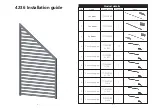
Key features include:
Optical connector end face inspection
Easy to change adaptor tips
Multi mode and single mode fiber patch cords
Sharp images displayed on VeEX V300 products
Visual comparison mode of saved image
The ISO/IEC 14763-3 standard for Testing Optical Fiber Cabling specifies visual standards for connector end face inspection with a
fiber microscope. The ISO-related standards and general industry practices recommend the following:
Markings on the core or damage to the cladding close to the core are unacceptable
Slight scratches and small pits on the cladding away from the core are, however, acceptable
Cracks are not permitted in neither core nor cladding
Equipped with 400x magnification, the VeEX Fiber Scope Inspector is well suited for general installation and maintenance checks on
both single mode and multi mode fiber types. Contamination or damage that cannot be viewed at this magnification is unlikely to
impact practical connector performance; thus, it is an ideal tool for patch cord inspection, optical laboratory or field test applications.
Lightweight construction and the ergonomic positioning of the rotary focus dial enables one-handed operation and fast viewing,
leaving one's hand free to move the connector under test as needed. Interchangeable screw-on adaptors are available for most
modern optical connectors, while the probe design blocks any hazardous infrared light from reaching the operator, resulting in
completely eye-safe operation.
9.1.1 Automatic Focus Detection and Analysis
In the past, fiber connector end-face inspection not only required a good Fiber Microscope (Fiber Scope), but a certain amount of
knowledge and hand-eye dexterity. Results were prone to inconsistencies, subject to interpretation and PCs were required for post
analysis against the criteria set forth by the IEC 61300-3-35 Sect 5.4 standard.
VeEX has made the task easier, faster and foolproof, with the introduction of its patent-pending revolutionary Automatic Focus
Detection technology. Turning ordinary digital fiber scopes, like DI-1000, into accurate semi-automated inspection systems. All with
the help of TX300S, FX300, RXT-1200 or SunLite OTDR test sets.
Instead of adding the extra complexity, fragility, cost, size and weight of other electromechanical focusing systems currently
available in the market, VeEX’s auto focus detection technology still relies on the incredible fast response and finesse of human
hands, but leaves the focus assessment, image capturing and analysis to the test set. A perfectly focused image of the connector
end-face can be achieved in a few seconds even with eyes closed. Moreover, manual control remains an option for non-trivial
scenarios that require the dexterity of human hands.
9.1.2 Main Advantages of Automatic Focus Detection
Investment protection (no need to replace existing scopes, like DI-1000, with a more expensive ones)
It’s a simple software option upgrade to the test set
Much faster focus, acquisition and analysis, compared to slow electro-mechanical auto-focusing scopes
Robustness: Less moving parts and no internal motors makes a better choice for field applications
No training necessary, yet get it right every time
Smaller scope size
Report generation (HTML and PDF)
The test set detects when the image has reached optimal focus level, automatically freezes the picture, captures the image
and runs the IEC 61300-3-35 analysis
No need to move hands or press any buttons (movement and vibration are common causes of focus loss)
No PC required for image acquisition or Pall/Fail analysis
9.1.3 The Importance of Fiber Connector Inspection
Dirty or scratched connectors introduce loss, increase ORL and/or damage other connectors (Loss becomes more critical at higher
data rates). End-face contamination is a leading cause of fiber link failures in data centers, corporate networks, MSOs and Telecom
CX380C User Manual RevA00
Page 65 of 105
















































